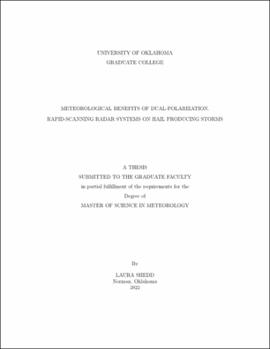| dc.description.abstract | Hailstorms continue to be one of the leading economic natural hazards in the United States, amounting to ten billion dollars in damage, on average, annually. Radar tech- nology is one of the best means of detecting hailstorms, especially from an operational standpoint, and the implementation of dual-polarization radars has enhanced this ca- pability. However, most operational radar systems to date have temporal update times that are insufficient for understanding some of the rapidly evolving microphysical and dynamical processes of hailstorms, such as drop shedding, melting of hail or variability of hailfall associated with updraft changes. As such, past studies have heavily relied on models and radar observations with insufficient update times on the order of 5 – 7 minutes.
Recent advances in radar technology have paved the way for a better analysis of hailstorms through the implementation of rapid scanning radar systems and innovative approaches to obtain faster scans. This study uses two radars providing rapid-scan observations, the Rapid X-band Polarimetric Radar (RaXPol) and KOUN to examine what rapidly evolving features can be resolved in hailstorms. RaXPol, a mobile X-band radar system, provides full volumetric update times of 24 seconds and with its close proximity to the storm, also provides high spatial resolution, thus allowing for some microphysical processes to be resolved in more detail. While KOUN does not update as quickly as RaXPol, it completes fast sector scans in 90 – 120 seconds, providing more detail than a conventional NEXRAD over a storms lifetime. RaXPol data were obtained from the 15 June 2017 supercell near Hays, KS that produced 2.5” hail. Using vertical cross sections, RaXPol is able to capture the rapid growth of the ZDR column as well as a hail fallout signature that becomes stratified into distinct layers. We hypothesize these layers to be associated with 1) large, dry hail, 2) smaller, melting hail, and 3) large drops from melting hail or drop shedding with the stratification resulting from size sorting. Since the hailfall occurs into a precipitation-free region, this provides a unique view of the temporal evolution of melting hail and size-sorting processes.
KOUN data were obtained from 4 hail-producing storms across 3 days. Similar to RaXPol, KOUN was able to capture vertically evolving features such as the growth and decay of the ZDR column and the three-body scatter spike. Vertical cross sections of ZH, ZDR, and ρhv allowed for hail fallout to be resolved, though the extent of the microphysical processes ongoing was more limited, especially when compared to the RaXPol data. Through the use of derived parameters, such as MESH and an HCA, KOUN was able to better capture the full lifecycle of a hailstorm, including the cyclic evolution of hail production and its relation to storm mode. This dataset was also emulated to a NEXRAD update time range to explore what features, such as the evolution of the TBSS, would not be resolved with a rapid-scanning radar system. Understanding the benefits of using a rapid scanning radar system will be advantageous for future phased-array systems and will provide more detail on the processes affecting hail growth and production both from the research realm, as well as detecting hail and other precursor signatures in warning operations. | en_US |

